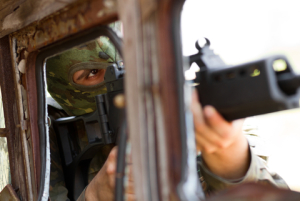Strange Bedfellows: Terrorists and Drugs

This past May, the DEA raided a Birmingham Alabama warehouse as a part of Project Synergy. Inside, agents found hundreds of thousands of “Scooby Snax” baggies containing spice (synthetic marijuana). Sales of the product were also linked to $40 million in wire transfers to Yemen. Yemen is the home base for Al-Qa‘ida in the Arabian Peninsula (AQAP). While not able to directly link the money to a particular group or organization, DEA spokesperson Rusty Payne said: “It doesn’t take a rocket scientist to figure out that people aren’t sending $40 million to their struggling relatives overseas.”
Derek Maltz, the director of the Special Operations Division of the DEA said: “There’s a significant, long history between drug trafficking and terror organizations.” More than 50 percent of the State Department’s designated foreign terrorist organizations (FTOs) are involved with the drug trade. While the Obama administration has been successful in cutting off state-sponsored funding for terrorist organizations, they have looked for other sources of revenue. The $400 billion annual international drug trade is the most lucrative illicit business in the world and a tempting “investment opportunity” for terrorists.
Maltz went on to say that the synthetic drug market is a “two-for-one deal” for terrorists—they undermine Western countries with the drugs and make millions in the process. We’ve put a bull’s-eye on our back, he said. “When you see a designer synthetic drug industry as lucrative as this in the U.S., it would only be natural that it would be a huge target for those trying to finance their terrorists.”
The world of narcoterrorism has some diversity in its investers. The Taliban in Afghanistan distribute heroin; FARC in Columbia deals in cocaine; and al Shabab in West Africa is alleged to sell khat. While the association of al Shabab and khat may be questionable (here and here), the links between the Taliban and heroin as well as FARC and cocaine are well documented.
While Afghanistan and growing opium have been linked for thousands of years, it has only been in the last three decades that it has become the center for worldwide opium cultivation. Since 2001, opium production in Afghanistan has increased from 70 percent of the overall global opium production to 92 percent. To give you a sense of the size of this, the 2013 World Drug Report indicated that in 2011, Afghanistan produced 5,800 tons of opium, down from 7,400 tons in 2007. The next largest opium producer in 2011 was Myanmar with 610 tons of opium.
The World Bank estimated that the opium GDP of Afghanistan is between $2.6 and $2.7 billion. This amounts to 27 percent of the country’s total GDP, both licit and illicit. And yet, only 3 percent of the natural agricultural land in Afghanistan is used for its production. Poverty is widespread in Afghanistan and many of farmers are compelled by economics and force to grow opium. “Opium is valued at over $4,500 per hectare, as opposed to only $266 for wheat.” Because of this potential profit, many farmers are pressured to cultivate opium by various organizations, warlords and landowners.
The provinces of Helmand and Kandahar, which were regularly in the news during the war in Afghanistan, are also the primary opium producing provinces in the country. As former Afghan president Hamid Karzia said: “The question of drugs . . . is one that will determine Afghanistan’s future. . . . [I]f we fail, we will fail as a state eventually, and we will fall back in the hands of terrorism.”
According to sources in Spanish intelligence, the Islamic State and other jihadist groups are using their connections in the illegal drug market to finance their operations in Iraq and Syria. Jihadists use their knowledge of drug smuggling routes to export arms, contraband and new recruits from Europe to Iraq and Syria. Ironically, the pressure to dry up legal fundraising for terrorist organizations has contributed to their increased trade with illegal arms and drugs.
According to reports from Spain’s recently established government intelligence and counter-terrorism unit CITCO, 20% percent of those detained in Spain under suspicion of working with Islamic State and other jihadist groups have previously served prison sentences for offences such as drug trafficking or document counterfeiting.
FARC rebels control over 60 percent of Columbia’s drug trade, including overseas trafficking. The Revolutionary Armed Forces of Columbia (FARC) earns about $1 billion annually from the production and sale of cocaine in Columbia. According to General Jose Roberto Leon, the head of the Columbian national police force, “We have information found on computers after operations that have captured or killed FARC leaders, and it’s involvement in drug trafficking is evident.” The Columbian anti-narcotics police chief, General Ricardo Restrepo, said that officials fear that if a peace deal with FARC is successfully negotiated, thus cutting into cocaine production, that new gangs producing synthetic drugs will emerge. “It will be our next battle.”
The connection between terrorism and drug trafficking does not currently get much attention in the news media, in part, because the connections are difficult to make. But it does exist and seems to be a growing trend. Spanish intelligence sources have reported that European jihadist groups are using drug smuggling routes to export drug contraband and new recruits from Europe to Iraq and Syria. And most of the cocaine entering Europe is reportedly going through territories controlled by the Islamic State.
The Birmingham bust discussed above is particularly disturbing to me as it connects the making and distribution of the newest addictive danger, new psychoactive substances (NPS), with terrorism. This combination truly is a two-for-one threat. But we can have a two-for-one response to that threat. Both the war on drugs and the war on terrorism can be fought by social policies as well as drug treatment and education that aim for the reduction of drug use. Who would have thought that the slogan in the war on drugs would someday be: Fight Terrorism by Becoming Drug Free.

